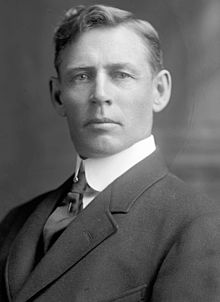Charles August Lindbergh
Charles August Lindbergh I (born January 20, 1859 in Stockholm , Sweden , † May 24, 1924 in Crookston , Minnesota ) was an American politician . Between 1907 and 1917 he represented the state of Minnesota in the US House of Representatives . He was the father of aviation pioneer Charles Lindbergh .
Life
In 1860 he came to the United States with his father Ola Månsson. The parents had recently separated and his father had to leave Sweden because of corruption allegations. On this occasion, the original family name Månsson was changed to Lindbergh. The family settled on a farm near Melrose , Stearns County , Minnesota. Lindbergh attended public schools in his new home including Grove Lake Academy and St. Cloud Normal School . After a subsequent law degree at the University of Michigan at Ann Arbor and his admission to the bar in 1883, he began to practice in Little Falls in his new profession. He also worked in agriculture.
Between 1891 and 1893, Lindbergh was a District Attorney in Morrison County . Politically, he became a member of the Republican Party . In the 1906 congressional election, he was elected to the United States House of Representatives in Washington, DC in the Sixth constituency of Minnesota . There he took over from Clarence Buckman on March 4, 1907 . After four re-elections, he was able to spend five legislative terms in Congress until March 3, 1917 . During this time, the 16th and 17th amendments to the constitution were passed. Lindbergh was an opponent of the Federal Reserve Act of 1913.
In 1913 he published the book Banking, Currency, and the Money Trust , in which he criticized the disintegration of the state by a wealthy elite. When, five years later , he wanted to publish the work Your Country At War , which historian Kathryn S. Olmsted considered to be conspiracy-theoretical and anti-Catholic , which blamed America's entry into World War I on a secret inner circle acting only in its own interest, the printing plates were made by Federal agents destroyed.
In 1916, Lindbergh decided not to run for the US House of Representatives again. Instead, he applied unsuccessfully as a candidate for the Nonpartisan League for a seat in the US Senate . Then he worked again as a lawyer. In 1917, Lindbergh committed against the American entry into the First World War . In 1918, he ran for governor of Minnesota to no avail . Lindbergh later joined the Farmer Labor Party . Within this party he applied for the nomination for the gubernatorial elections in 1924. He died of a brain tumor before the party's primary elections.
Fonts
- Banking, Currency, and the Money Trust . 1913 ( digitized ).
- Your Country At War, and What Happens To You After a War . Philadelphia 1917 ( PDF ).
Web links
- Charles August Lindbergh in the Biographical Directory of the United States Congress (English)
- Charles August Lindbergh in the database of Find a Grave (English)
Individual evidence
- ^ Kathryn S. Olmsted: Real Enemies: Conspiracy Theories and American Democracy, World War I to 9/11 . Oxford University Press, Oxford 2013, ISBN 978-0-1997-5357-4 , p. 13
| personal data | |
|---|---|
| SURNAME | Lindbergh, Charles August |
| BRIEF DESCRIPTION | American politician |
| DATE OF BIRTH | January 20, 1859 |
| PLACE OF BIRTH | Stockholm , Sweden |
| DATE OF DEATH | May 24, 1924 |
| Place of death | Crookston , Minnesota |

